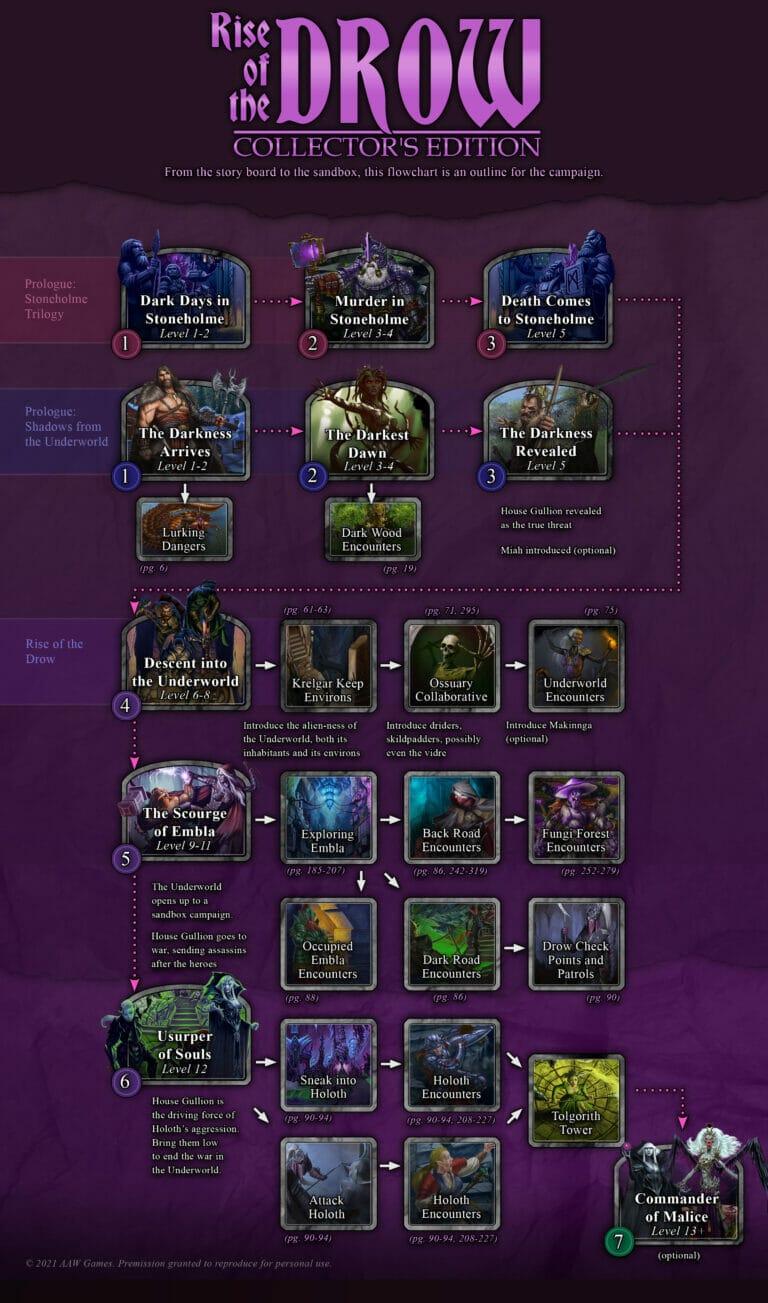From Script to Sandbox: A Rise of the Drow Outline
To help you plan your campaign and provide ongoing support for Rise of the Drow: Collector’s Edition, we’ve created this outline and flowchart. This resource highlights key transitions in gameplay and serves as a Rise of the Drow outline to help GMs navigate the story’s shift from linear to sandbox elements.
🔗 Click here to view the Rise of the Drow Collector’s Edition
Prologue Overview: From Stoneholme to Shadows
The Collector’s Edition includes two prologue options. The first is the story-driven Stoneholme Trilogy, and the second is Shadows From the Underworld, which slowly transitions into sandbox gameplay.
Stoneholme Trilogy
The Stoneholme Trilogy of adventures were designed with milestone leveling and introduce a more guided start to your campaign. While they lack the open-ended feel of the collector’s edition prologue, they are perfect for a full Underworld-based campaign.
Shadows From the Underworld
This prologue takes characters from 1st to 5th level and begins to shift toward sandbox-style play. It introduces the Rise of the Drow outline naturally:
- The Darkness Arrives: A brutal dungeon crawl with heavy script.
- The Darkest Dawn: A blend of scripted and exploratory overland content.
- The Darkness Revealed: Full sandbox. The players must determine how to tackle Adrik’s Folly without a predefined solution.
Collector’s Edition Sandbox Transition
Once in the Underworld, the story formally begins, and the sandbox takes full effect. Characters should be 5th or 6th level by now. From here, the Rise of the Drow outline focuses less on a single path and more on player agency and exploration.
Part 4: Descent into the Underworld
This chapter is light on core plot developments but filled with potential. GMs should:
- Add thematic random encounters using pages 242–249.
- Encourage exploration (e.g., Ossuary Collaborative, Krelgar Keep).
- Insert clues or rumors about Holoth and Tolgorith Tower.
Key Experience Gaps in the Rise of the Drow Outline
Part 5: The Scourge of Embla
This chapter begins with an assassination and transitions into pure sandbox. Players may:
- Engage Embla as a hub for exploration.
- Raise an army or wander off-path.
- Ignore guidance and suffer consequences.
Between Embla and Holoth, there’s a significant experience gap. Use:
- Back Road and Dark Road encounters.
- Moss caverns, dweorg merchants, or custom side quests.
Part 6: Usurper of Souls
The climax can be linear or fully open. GMs can:
- Use Tolgorith Tower and the Spider Temple as scripted dungeons.
- Or treat Holoth as a sandbox city.
Looking for a mass combat or faction war system for this chapter? Let us know!

Rise of the Drow Outline: Final Thoughts for GMs
This Rise of the Drow outline allows you to adapt the Collector’s Edition for your table. Track level progression, spot XP gaps, and embrace sandbox flexibility. Creative GMs will find opportunities to expand the world beyond what’s written.
Let us know in the comments or join our Discord to share your questions and feedback.
Darkness Rises, and the Time is Now…
Align with House AAW and be the first to uncover new quests, ancient powers, and revelations from the Underworld.
The bond is sealed.
Watch your inbox — the first whisper from House AAW draws near, carrying secrets from the deep places of the world.


I would love to see Stoneholm remastered. Anything to flesh out the setting and bring it up to par with newer releases.
I would also love to see the Stoneholme trilogy remastered and updated to match the collector’s edition!!